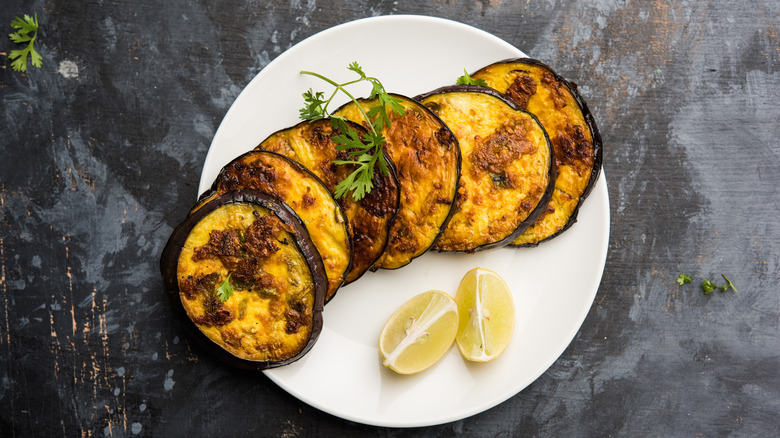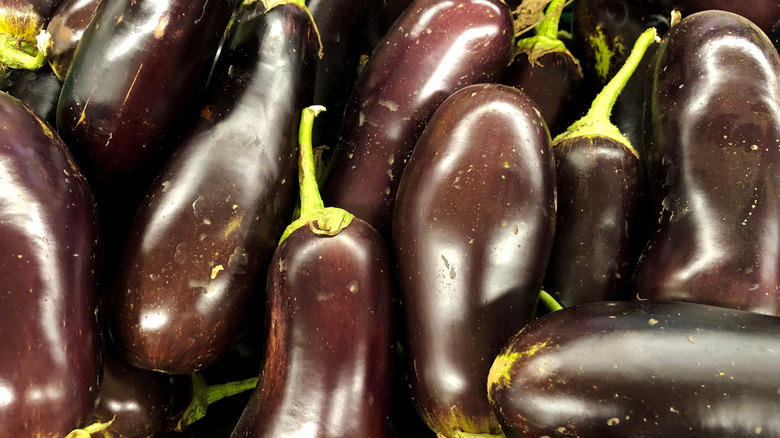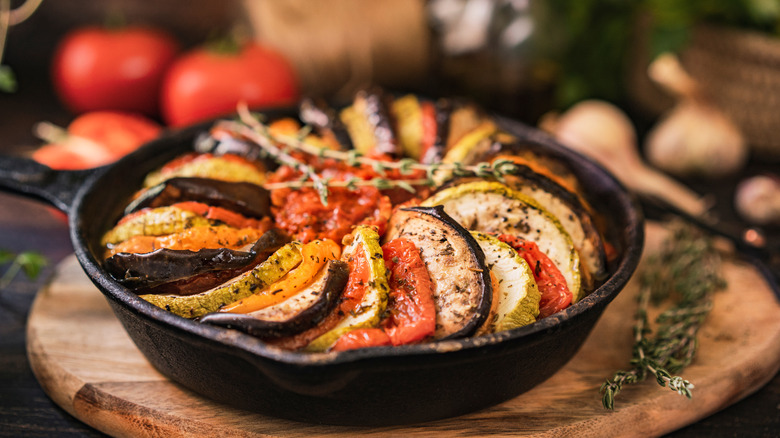The Real Reason Your Eggplant Isn't Crispy
A mainstay of vegan and vegetarian cooking, as well as one of the most prominent types of produce used in main entrees, eggplant is a stalwart of the culinary world. Unfortunately, though, many are often stymied by the complexities of cooking it, sometimes finding it bitter, soggy, mushy, or otherwise unappetizing. When it's done well, though? It's unbeatable.
As astutely noted by The Awl, eggplant "is DECADENT. It is INDULGENT. It is LUXURIOUS." We couldn't phrase it any better. The surprising truth about eggplant is that it's just as versatile as more common vegetables like potatoes or cauliflower. From eggplant parmigiana and caponata to ratatouille, baba ganoush, and eggplant curry, the fruit-that-many-assume-is-a-vegetable is a protagonist of many dishes — and for good reason.
What are the tricks of the trade? How does one ensure that eggplant cookery is proper and the result is crisp, tender, and deeply flavorful, whether the eggplant is the main component or a quick side? Here, we've assembled the best tips to make your eggplant crispy every time.
How to prepare eggplant
Lancaster Online swears by a tip that many chefs also abide by: the pre-cook salting, specifically stating to "sprinkle coarse or sea salt on sliced eggplant and let it sit for 10 to 20 minutes" before rinsing, drying, and cooking as you would normally. This is said to bolster the inherent textural and structural integrity of the eggplant itself, as well as release some of the moisture that can hinder proper browning or crisping. The outlet also notes that a peeled eggplant will naturally be slightly less bitter.
On the other hand, Blue Apron notes that overtly bitter eggplant is a thing of the past, stating that the majority of today's eggplants don't require pre-salting to mitigate bitterness. Regardless, pre-salting can always be great idea whenever you're looking to really crisp up your eggplant as best as possible. Furthermore, some note that salting can also be dependent on the type of dish being made. For example, Today notes that there's no need for pre-salting when you're making a "dish like ratatouille, pureed eggplant, or any other stew recipe."
Another great tip? As noted by Bon Appétit, breading or coating your eggplant prior to cooking can be helpful across the board, lending texture, flavor, and helping to mitigate any excessive oil absorption. The breading essentially forms a shield that'll help prevent the spongy-like oil soaking that might happen otherwise.
How to cook eggplant
When it comes to the actual cookery, Allrecipes notes that it's important to keep your eggplant evenly spaced and not overcrowded, or otherwise you risk steaming them instead of getting a rich, proper caramelization. The ideal end texture is a crisp, caramelized exterior with a soft, nearly melt-in-your-mouth interior. Allrecipes also warns not to overuse oil while cooking, because eggplant's porous nature can very easily soak it all up and then your eggplant will be greasy, laden, and not especially appetizing. Lastly, Allrecipes notes that eggplant is not a vegetable that can be cooked super quickly, and that it should be cooked for a minimum of 15 to 20 minutes before it can be consumed. Undercooked eggplant is not an alluring flavor; trust us!
Furthermore, The Kitchn references a technique from Nancy Silverton that actually involves baking an eggplant in a baking sheet that is placed "directly on the bottom of the oven." Be mindful, though, because this method can very easily burn your eggplant if you're not frequently turning it, with The Kitchn also noting that it can "produce a lot of steam, so be careful when you open the oven door."
Take heed and use these tips the next time you're feeling hesitant about cooking an eggplant dish, and you may just be met with crisp, perfectly browned eggplant with a silky interior.


